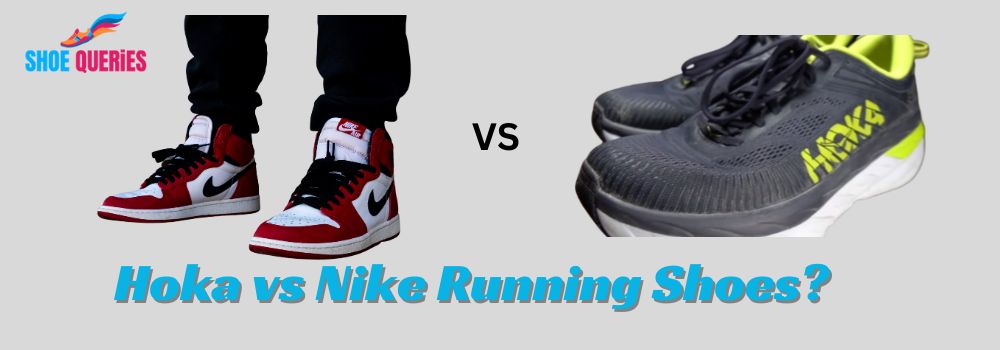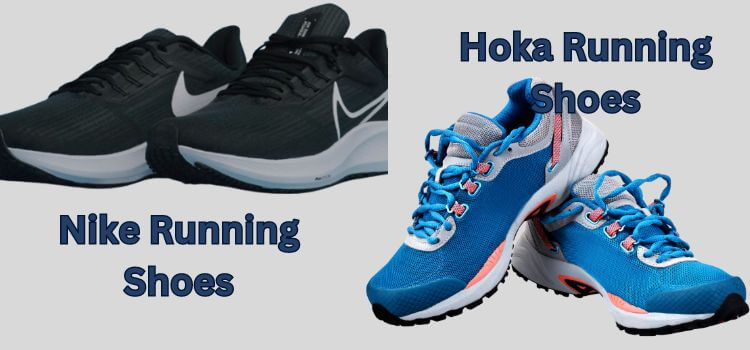In the world of athletic footwear, there are two giants that stand out: Hoka vs Nike Running Shoes. Both brands have gained popularity for their exceptional qualities and performance.

The right pair of shoes is crucial for fitness enthusiasts and athletes. In this article, we compare Hoka shoes with Nike shoes.
Quick Answer: Hoka and Nike are like the Batman and Superman of the running shoe world, each with their own superpowers. Hoka, known for its cloud-like cushioning and maximalist design, offers a unique running experience.
While Nike, the athletic footwear giant, boasts a wide range of styles and technologies, including the iconic Air cushioning. The choice between these two goes beyond comfort and style.
Hoka vs Nike Running Shoes Feature Comparison:
Weight:
Hoka shoes, with their maximalist design and plush cushioning, tend to be slightly heavier. Cushioning is a priority for long-distance runners who prefer comfort over speed
Each Nike model has a different weight range. You can find lightweight options designed for speed and performance. If you’re looking for a shoe that won’t weigh you down during sprints or races, Nike has you covered.
Breathability:
Due to their maximal cushioning, some Hoka models may offer less breathability. However, newer models are designed with improved ventilation features to enhance airflow.
Nike focuses on balancing cushioning and breathability, with many of their running shoes incorporating breathable materials and innovative ventilation systems to keep your feet cool and dry.
Terrain Suitability:
Hoka shoes, with their cushioned and shock-absorbing design, excel on road surfaces. They are a great choice for road runners looking for maximum comfort.
Nike provides a wide range of shoes suitable for various terrains, including road, trail, and track. If you’re an all-terrain runner, Nike’s got the options to match your preferences.
Foot Arch Support:
Hoka shoes are well-known for accommodating a wide range of foot arch types. They offer models for neutral runners as well as those with overpronation tendencies.
Nike, like Hoka, offers running shoes for different foot arch types. Their range includes options for flat feet, high arches, and neutral runners.
Environmental Considerations:
Hoka has taken steps to reduce its environmental impact. Some of their shoes use recycled materials and sustainable production processes.
Nike is also committed to sustainability and has introduced eco-friendly practices into its production. Nike’s “Move to Zero” initiative is an example of their dedication to reducing waste and environmental impact.
Community and Brand Values:
Hoka has a reputation for fostering a supportive and inclusive running community. Many Hoka enthusiasts appreciate the brand’s commitment to social and environmental responsibility.
Nike has a strong presence in sports and athletics around the world. To drive social change and promote inclusivity, Nike often collaborates with athletes and organisations.
Innovation:
Hoka has gained recognition for its innovative maximalist cushioning design. They continue to push the boundaries of cushioning technology to enhance runner comfort and performance.
Nike is synonymous with innovation in sports footwear. They have introduced groundbreaking technologies like Nike Air and Nike React foam, constantly striving to enhance performance, comfort, and style.
Customization:
Hoka offers limited customization options through their “Hoka One One Custom” program, allowing you to personalize some of their models to match your style.
Nike provides extensive customization options through the Nike By You program, enabling you to design a shoe that’s uniquely yours, from color choices to personalized text.
Brand Legacy:
Hoka, although newer compared to Nike, has gained a loyal following for its unique maximalist design and cushioning technology.
Nike is an industry veteran with decades of experience and a rich legacy of supporting athletes and sports communities worldwide. They have left a lasting impact on sports and athletic fashion.
Celebrity and Athlete Endorsements:
Hoka has gained attention in the running community and among elite athletes. Notable names like Olympic gold medalist Gwen Jorgensen have endorsed Hoka shoes.
Nike boasts an extensive list of celebrity and athlete endorsements, including iconic figures like Michael Jordan and LeBron James.

Hoka vs Nike Running Shoes: Main Differences:
Let’s dive into the specifics and see how these running shoe titans differ:
Durability:
When it comes to durability, Hoka shoes are designed to withstand the miles. Hoka shoes are known for their durable construction and high-quality materials, which often outlast many other running shoe brands. Runners who don’t want to constantly replace their shoes will appreciate their durability.
On the other hand, Nike running shoes are also known for their durability, but it can vary depending on the specific model. Some Nike shoes may wear out quicker, especially if you’re putting in high mileage. It’s essential to consider your running habits when choosing a Nike model, as some are more suitable for long-term use.
Fit:
Hoka shoes are celebrated for their wider toe box and plush fit. This feature makes them a popular choice for runners with wider feet or those who prefer a roomier fit. The generous toe box allows your toes to splay naturally, reducing the risk of discomfort or blisters during long runs.
Conversely, Nike offers a variety of fits across its extensive range of products. There are a variety of sizes and styles of Nike shoes available to suit your comfort preferences. Just like Cinderella’s glass slipper, you can find the perfect fit.
Cushioning:
Hoka’s claim to fame is its pillow-soft cushioning. If you want a shoe that feels like you’re running on clouds, Hoka is a top choice. The ample cushioning in Hoka shoes is ideal for those with joint issues or runners who crave a plush landing with every step.
Nike, with its diverse cushioning technologies, offers a wide range of options. From the responsive Zoom Air to the soft and resilient React foam, Nike caters to a spectrum of preferences. Whether you prefer a more responsive ride for speed or a softer cushion for comfort, there’s a Nike shoe for you.
Stability:
For overpronators or runners who need added stability, some Hoka models provide features to support a more stable gait. These models incorporate support technologies like J-Frame or EVA stability frames, making them a good choice for those needing pronation control.
Nike also offers stability shoes, such as the Nike Air Zoom Structure series, designed to support runners who overpronate. While Nike’s stability offerings may not be as maximalist as Hoka’s, they provide the necessary features to help you maintain a balanced and stable stride.
Affordability:
Hoka shoes are an attractive choice for budget-minded runners. No need to sacrifice performance when choosing Hoka; therefore making them an economical selection.
Nike provides runners with an expansive selection of running shoes to meet any budget. No matter if they prefer more cost-effective models or more premium technology options, Nike provides something suitable.
Support and Pronation Control:
For runners in need of support and pronation control, both Hoka and Nike have you covered.
Hoka offers models like the Hoka Arahi 5, which incorporate support features such as the J-Frame and EVA stability frame. These elements help keep your gait stable and minimize overpronation, making them suitable for runners with such needs.
Nike, too, offers stability shoes. The Nike Air Zoom Structure series, for instance, is engineered to provide the support required to maintain a balanced and stable stride, particularly for those who overpronate. With both brands, you’ll find options to cater to your specific support needs.
Trail Running:
If you’re venturing off the beaten path and hitting the trails, both Hoka and Nike offer trail running options.
Hoka boasts a range of trail-specific models, like the Hoka Speedgoat, designed to tackle challenging terrains. These shoes come with aggressive outsoles for optimal grip and superior cushioning to protect your feet during rocky or uneven terrain runs.
Nike offers trail running shoes such as the Nike Pegasus Trail. While not as specialized as Hoka’s trail offerings, Nike’s models provide good traction and durability for those who enjoy off-road adventures.
Minimalist vs Maximalist Design:
Another aspect to consider is the design philosophy of the two brands. Hoka is known for its maximalist design, which is characterized by a significant amount of cushioning and a unique sole shape. If you love the feeling of running on plush clouds, Hoka’s maximalist approach is sure to please.
The Nike Free series, for instance, is a minimalistic option, while the Nike Air Max is a maximalist option. Your personal taste and running style can be reflected in the variety of designs available.
Hoka Pros and Cons
Pros:
Exceptional cushioning: Hoka shoes are packed with extra cushioning, reducing the impact on your joints and ensuring a comfortable running experience.
Lightweight design: Despite their cushioning, Hoka shoes manage to remain surprisingly lightweight, making them suitable for a variety of athletic activities.
Wide toe box: The roomy toe box provides ample space for your toes to splay, reducing the risk of blisters and discomfort.
Cons:
Bulky appearance: Some people may not like the bulkier look of Hoka shoes, as they can appear less sleek compared to other brands.
Nike Pros and Cons
Pros:
The trendy designs of Nike shoes make them perfect for both sports and everyday wear.
Shoes from Nike can be customized to fit a variety of sports and activities.
In order to improve performance and comfort, Nike invests continuously in research and development.
Cons:
Nike running shoes generally have less cushioning compared to Hoka, which may not be ideal for individuals seeking maximum comfort.
Some Nike models tend to have a narrower fit, which may not be suitable for those with wider feet.
Making the Right Choice: Hoka vs Nike Running Shoes
Selecting between Hoka and Nike comes down to your personal preferences and needs, so when making your choice it is important to consider various elements:
Activity: Does Your Sport Require Long-Distance Running or Can It Multiply to Multiple Activities? If the former applies, Hoka’s maximalist design could make them ideal, while Nike may provide greater versatility for all sorts of athletic pursuits and activities.
Comfort: If cushioning and comfort are top priorities, Hoka is an excellent option; however, if sleeker aesthetics with less cushioning are preferred then Nike could be more suitable.
Style: Looking to turn your athletic shoes into fashion statements? Nike may offer designs more suitable to your tastes.
Final Decision: Hoka vs Nike Running Shoes
In making the final decision between Hoka and Nike, it’s essential to consider your specific running needs, style preferences, and values. Hoka is known for providing maximum comfort and cushioning during long runs, making them the ideal option to protect joints during strenuous activity. Nike provides more variety when selecting shoes to meet individual performance and style preferences.
As a runner, it’s important to carefully consider features like cushioning, breathability, durability and terrain suitability when choosing running footwear. Other considerations might include budget, brand values and customization options – ultimately your decision should reflect your running goals, personal running style and what feels most comfortable on your feet.
FAQs: Hoka vs Nike Running Shoes

A K M Azad, The Founder of Shoe Queries, In 2023, I set out on a remarkable journey into the world of footwear, driven by an unwavering passion for shoes. His enthusiasm for renowned brands such as Nike, Birkenstocks, Hey Dudes, Crocs, Vans, Uggs, Converse, New Balance, and many others fueled his dedication to disseminating in-depth research on a wide array of footwear styles.
